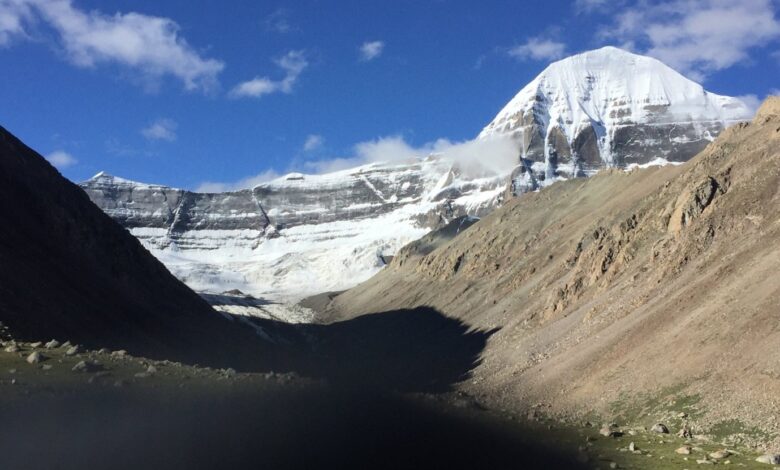The best time to visit Mt.Kailash: Seasonal Insights

Mount Kailash is located in the western part of the stunning Trans-Himalayas region of the Tibetan plateau. Mount Kailash at an altitude of 6638m is considered a sacred site for followers of Buddhism, Hinduism, Jainism, and Bon, an ancient Tibetan religion. The majestic Mt.kalish in China’s Tibet Autonomous Region’s Ngari Prefecture is a rich religious and cultural region, filled with flawless natural beauty and challenging trekking routes. Hence every year thousands of pilgrims and adventure lover tourists from all over the world travel to Mt. Kailash for an adventurous yet spiritual experience.
Mount Kailash is not only rich in spiritual aspects but also natural beauty aspects that the region has to offer. The region also offers an experience of the rich cultural legacy, local ethnic valleys, different monasteries and temples as well as Lake Mansarovar which is one of the main highlights of the region. The holy lake Mansarovar is one of the many other magnificent natural sites in the Kailash region which attracts tourists from all over the world. The journey in Mt Kailash region takes you through a breathtaking spiritual journey known as the Kailash Mansarovar Yatra is held in Tibet’s isolated region. The journey takes you through a pleasant and soothing experience by the highest mysterious freshwater lake Mansarovar in the presence of the tall snow-capped Mt. Kailash.
Seasons and Weather conditions in Mt.kailash
As you know Mt Kailash offers visitors a spiritual as well as satisfying visual experience through its beautiful scenic surroundings However, it is important to decide when to visit Mount Kailash and the surrounding locations. So one must have a full-fledged plan before heading out for Mt Kailash. Among the other factors to be considered seasonal variations and weather patterns turn out to be some of the most important factors. Hence one must have full knowledge and first-hand information about the seasons and the weather conditions of Mt Kailash before traveling. Here we list out some seasons and their characteristics in the Mt Kailash region. So make sure you read until the end!
Spring season
Spring season which spans from April to June is the most ideal month to visit Mt Kailash. Although the weather might feel a little chilly spring season marks the end of the severe freezing winter season, displaying the tranquil Lake Mansarovar and the majestic Mount Kailash. The fine weather and clear skies are perfect for trekking and sightseeing. In this season the roads are well-kept and clear as well the the lush vegetation is in full bloom which makes the journey even more pleasant and soothing. Hence this is a perfect time of year to visit the holy mountain and go on the strenuous Mt Kailash Trek because of the clear skies, rising temperatures, and more comfortable weather. Trekking and taking in the breathtaking scenery are made possible by the excellent weather and good visibility throughout these months. Although the spring season seems to be the best season to travel detailed planning and safety measures are required as weather can go sideways at any moment in those regions.
Monsoon season
Monsoon is one of the best seasons to visit Mount Kailash as the region’s temperature hovers around temperate temperatures, which range from 10 degrees Celsius to 20 degrees Celsius. The monsoon season is known for heavy rainfall which increases the humidity of the surroundings making the air damp which ultimately lessens the negative impacts of high altitude, making visitor experiences more comfortable. The monsoon season also coincides with the summer season which creates a perfect balance of the weather conditions in the region making the journey pleasant and easy. With lovely summer blooms scattered throughout the grasslands, the plains and prairies are at their most picturesque, and the grass is lush and green. Visitors can enjoy a more pleasing visual experience thanks to the abundant vegetation and rejuvenated landscape. Although the temperature might up to reach 22 degrees Celsius it surely will not take you through an unpleasant and displeasing journey. Hence, making this one of the most preferred seasons to visit the Mt. Kailash region
Autumn season
After the monsoon season, autumn which runs from September to the end of October brings steady, dry weather. Another great season to trek, with clear blue skies and beautiful
snow-capped mountain scenery.The skies soon clear and the warmer weather that follows the summer lasts far into September once the monsoon rains have passed. Although the autumn season is known for its dry and calm weather conditions there might still be a minimal prospect of rain because the weather is uncertain in the region. But overall It’s mostly dry and clear outside, with a gradual cooldown near the end of October. The autumn season might be dry but it offers bright and clear skies with an ideal temperature and lush and green landscape along the journey. But no matter how much the weather seems to be ideal planning beforehand and keeping track of the weather is a must for a memorable and safe journey.
Winter season
November through March is the season of winter. During this season visitors are not recommended to visit Mt. Kailash and the surrounding areas. The region endures bitter cold throughout these months, with frequent low temperatures below freezing, particularly at night. With most days reaching below-freezing and nights reaching as low as -20 degrees Celsius in January, the coldest month of the year. There is also a chance of heavy snowfall, which can close several trekking routes making them impossible to travel. The authorities may also come into action and may impose access restrictions as winter brings a lot of challenges such as blocked routes, visibility issues, freezing temperatures, and many more due to plummeting temperatures. Furthermore, because of the colder temperatures and reduced oxygen levels during this time, there is a greater chance of altitude sickness. During
this season many local inhabitants also face severely frigid winter conditions forcing them to move to the warmer parts of the region due to which there may be fewer or no amenities available to travelers during this period, including lodging and dining options.
Read more Planned Preventive Maintenance: Elevating Operational Excellence
An ideal season to visit Mt. Kailash?
May through September are the ideal months to visit the Mt. Kailash region. The weather is usually stable and less rainfall occurs at this time of year, which makes the hiking routes safer and easier to reach. Additionally, the temperatures are more pleasant and moderate, with beautiful clear skies and high visibility which is good for lengthy hikes. In addition, you will also travel through numerous monasteries and temples and the highest freshwater lake Mansarovar which is the highlight of the journey along the route.
Although the above-mentioned seasons are peak seasons. It has its set drawbacks despite providing a nice atmosphere and ideal weather. During these months the Mt.kailash trails may get overcrowded since it is the peak season, making the hike unpleasant. The certainty of weather might not be guaranteed as weather sometimes turns unfavorable which might cause flight delays or an obstruction along the journey.
Conclusion
Mt. Kailash is an amazing adventure and spiritual journey with a physical aspect to it. Many visitors from all over the world visit this region to experience the rich spiritual and religious aspects. Despite the steep elevation, inclement weather, and treacherous road. Your mental and physical stamina will be put to the test on this tour. Selecting the ideal period will therefore assist you in being both physically and psychologically ready. Hence the outcome of the trip depends on your decision-making process since many internal and external factors might influence it. Seasons and weather conditions are crucial factors that can make or break the journey on the mountains of Kailash. Therefore one must gather the information, plan, and execute accordingly for an unforgettable trip that leaves you with priceless memories and deep spiritual experiences. So hurry up and pack your bags and take on the Mt Kailash trip an adventurous yet spiritually fulfilling journey.
Source: https://abovethehimalaya.com/kailash-mansarovar-yatra.html





